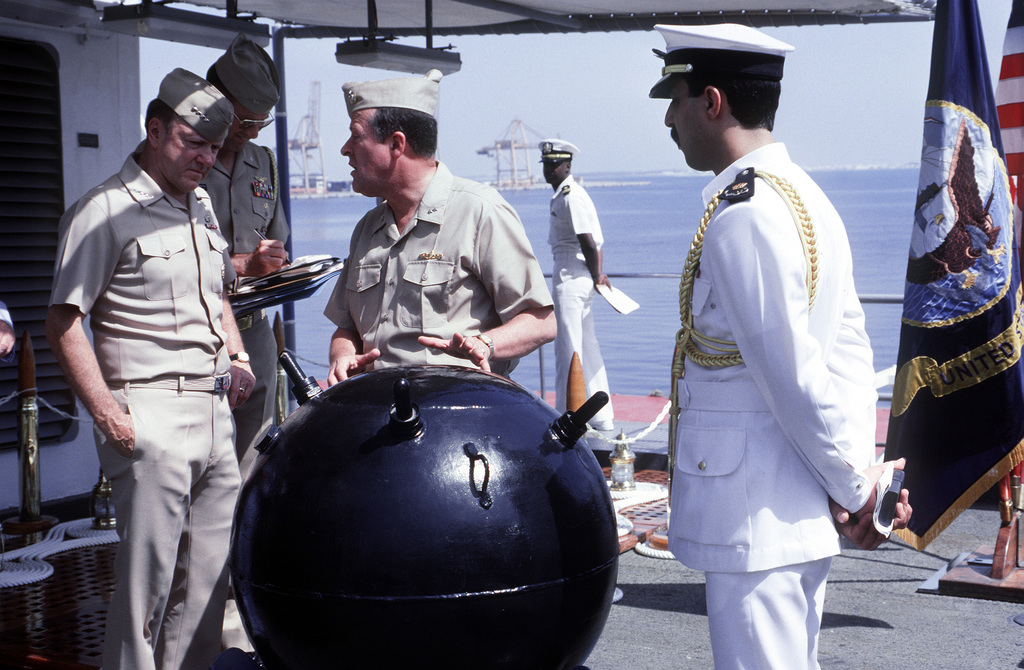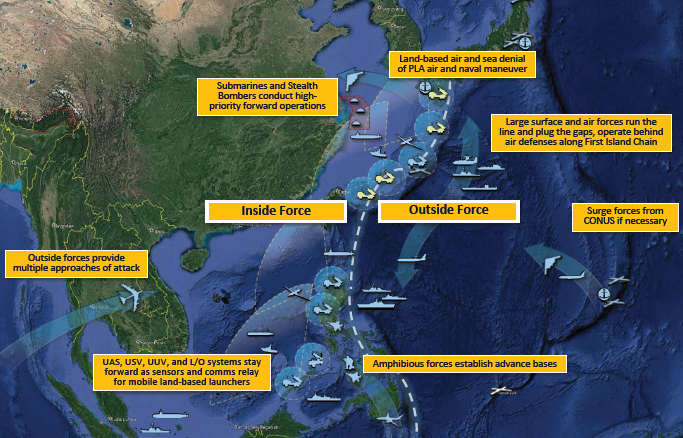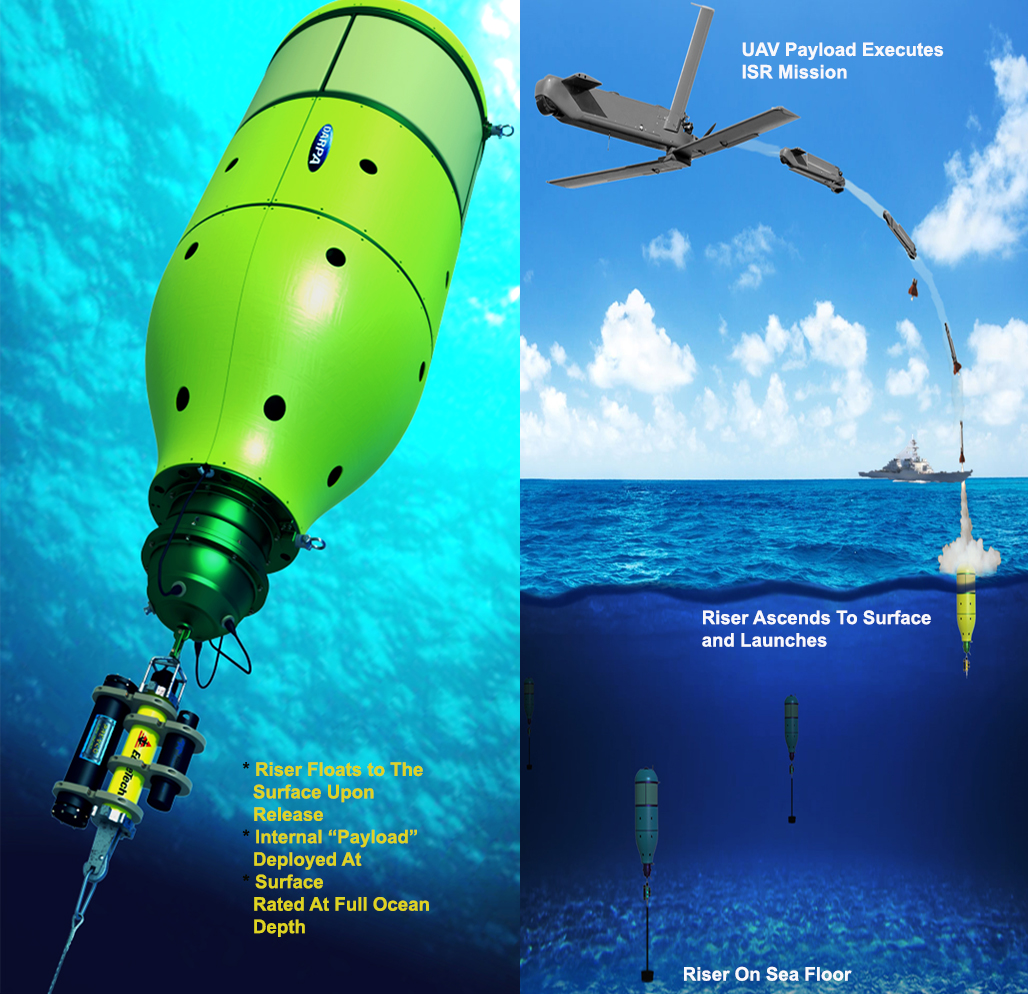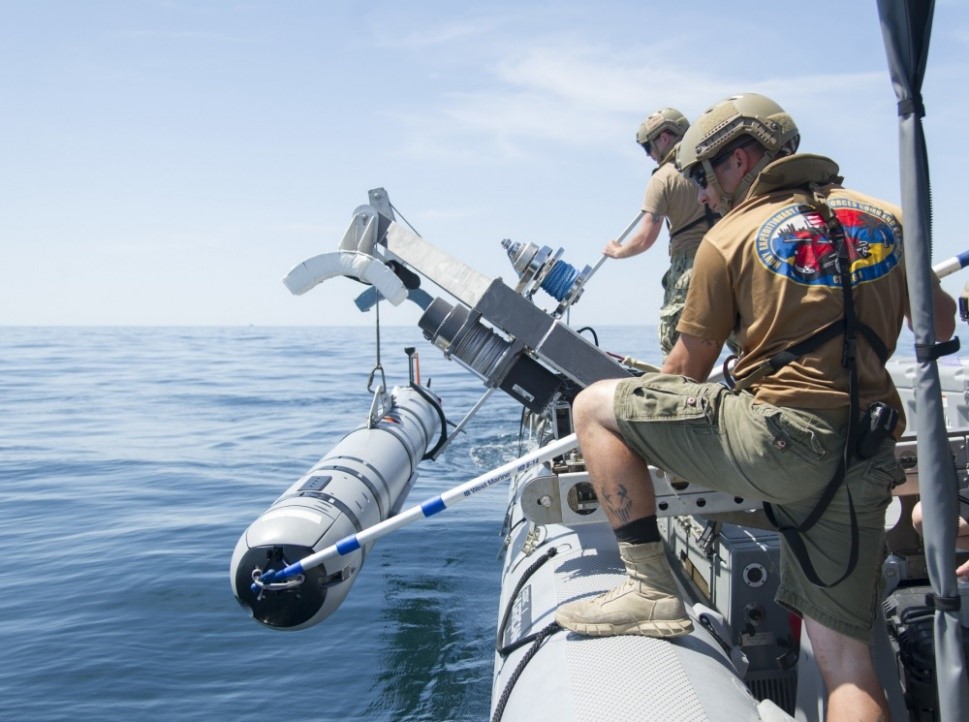Chokepoints and Littorals Topic Week
By Major Brian Kerg, USMC
A Game of Go
The primary objective of the game of Go is the control of territory. Players do this by laying stones in ways that maximize the connectedness of their own pieces, deny connectedness of enemy pieces, and in ways that mark out the most territory on the board. Open spaces next to any stone are called ‘liberties,’ and marks opportunity for connection or disconnection. Placing your stone on an enemy stone’s liberty cuts off your opponent’s options.
It is possible to capture enemy stones by taking away the last liberty of any group of connected or individual stones. Competitive stone laying where capture is the likely outcome is equated to a ‘fight.’ Novice players often focus on winning a fight with their opponent, as they spend several turns laying stones in ways that allow them to completely surround their opponent’s group. But the overall goal is not maximizing the amount of stones captured. Preoccupation with capturing stones will lead a player to lose momentum and initiative while their opponent spends those turns carving out territory, maximizing strategic control of the entire board, and ultimately winning the game.
This is the challenge the sea services face as they pursue the goals of the 2018 National Defense Strategy.1 As the United States embarks on a period of great power competition with potential adversaries, the Navy and Marine Corps are focused on achieving deterrence by denial through means of sea control and sea denial. While naval forces must be able to win a conventional conflict should one break out, the risk of escalation to a nuclear exchange puts a premium instead on convincing adversaries that conflict isn’t worth the risk. Defense planners seek this objective by constricting enemy maneuver and decision space, and by canalizing opponents toward de-escalatory off-ramps. While the risk of war is present, the goal is not to capture or kill enemy forces – it is instead to control territory to obtain a strategic victory without fighting – Sun Tzu’s acme of skill.
The littorals are home to key maritime terrain that will define this battle for control of the global commons. To date, the sea services have focused their efforts on developing mutually reinforcing operational concepts that will achieve sea control and sea denial in this space. Distributed Maritime Operations (DMO) seeks to mass effects without massing forces, mitigating the vulnerabilities of U.S. Navy ships at the outset of any potential conflict by placing them as stand-off forces outside of an enemy’s Weapons Engagement Zone (WEZ) until threats have been reduced or sea control is achieved.2 Sea control will be initially achieved by Expeditionary Advanced Base Operations (EABO), which will place Marine Corps teams as stand-in forces to persist forward inside the WEZ, where combinations of mobile sensors and shooters will deny enemy freedom of action in the maritime domain.3 With enemy A2/AD capabilities checked by stand-in forces, stand-off forces will once again enjoy freedom of maneuver in the area of operations. When applied to archipelagic defense, such as across the first island chain, these concepts are inherently about imposing high-threat chokepoints on an adversary from the littorals.
While bold and full of potential, EABO and DMO possess their own gaps. If naval forces were projecting the power of EABO and DMO on a Go board, or oban, there would be points where they would lack connectedness, and where an adversary would maintain liberties. To better explore means by which strategic chokepoints in the littorals can be controlled, the sea services must revitalize mine warfare.
Naval mine warfare (MIW) has played a significant role in every major American military conflict.4 If employed in support of sea control strategies under development by the Navy and Marine Corps, and should its full potential be leveraged by emerging technologies, MIW can serve as the lynchpin for deterring aggression in the maritime domain, and if necessary, for defeating adversaries at sea.
Where is Mine Warfare?
As sea control concepts, EABO and DMO are incredibly promising. They have generated great attention and energy from national security specialists and military thinkers, resulting in a high yield of thought pieces that have informed official military publications. This conversation has mostly focused on the integration of naval forces in support of DMO and EABO, new ways to employ existing capabilities for sea control, and what new capabilities need to be acquired or developed to provide sea denial.
But one topic that has not seen nearly enough discussion is the application of MIW in support of deterrence or denial. Most glaringly, official sea service documents are silent on the subject of MIW’s role in modern naval strategy. A Design for Maintaining Maritime Superiority 2.0, which was revised explicitly to align with the 2017 National Security Strategy and 2018 NDS, does not even include the word ‘mine,’ let alone any MIW related subjects.5 The Littoral Operations in a Contested Environment concept passingly mentions the need to consider command and control operations for Navy mine warfare capabilities, and only mentions MIW twice more but in terms of mine countermeasures, not Navy MIW employment.6 All other official sea service publications are similarly glib on the topic. The only solid connection between the potential for MIW in reference to deterring China is made in a 2015 Foreign Affairs article discussing archipelagic defense, years before the release of the current NSS and NDS.7
The absence of mine warfare in these discussions should be shocking to maritime strategists given the incredible historical utility of MIW. Mines have damaged or sunk more ships over the past 125 years than all other weapon systems combined.8 The lack of consideration for MIW preceding its decisive employment in America’s wars is the repetition of an old tune. To take one example, prior to the start of the Second World War, the U.S. Navy hadn’t built a minesweeper in its history.9 By the war’s end, the U.S. had laid thousands of mines which sank hundreds of Japanese ships, critically disrupting Japanese maritime shipping.10 After years of stilted progress in the Vietnam War, the mining of Haiphong Harbor was a critical factor in compelling America’s enemies to start negotiating for an end to the war.11

Today, the pendulum has swung back in the direction of limited consideration for MIW. The U.S. Navy has only two types of mines in its inventory, the aircraft-laid Quickstrike and the Submarine-Laid Mobile Mine (SLMM). And despite a military technology renaissance that is characterized by autonomous systems, human-machine teaming, and the Internet of Things (IoT), scant energy has been directed toward pairing disruptive technologies with MIW, let alone for the purposes of sea control or sea denial. The most recent Navy-sponsored innovations in MIW, the Quickstrike-J, Quickstrike-ER, and the Hammerhead, only allow for more precise deployment of existing mine capacity.
MIW can critically reinforce control of key maritime terrain, particularly at strategic chokepoints in the littorals. This is possible by understanding the potential that MIW brings to the sea control and sea denial strategies under development by the Navy and Marine Corps, and by employing current and emerging technologies to support the new and repurposed force design.
Employing Mine Warfare in Sea Control
A critical aspect of sea control strategy is the control of key maritime terrain. This includes any area, ashore or at sea, that when controlled enables influence over the maneuver of others conducted in, on, or around that area. Imagine a small, concealed team of Marines operating from an Expeditionary Advanced Base (EAB) somewhere in the South China Sea, armed with a long-range precision fires system with a threat range of 300 nautical miles. By virtue of its location and the influence its weapon system has on maneuver around its location, this EAB force is occupying key maritime terrain and executing sea denial. By the same token, a U.S. Navy surface ship with a threat range around the Straits of Malacca would similarly provide sea control at key maritime terrain.
In the sea control envisioned by naval planners to execute the 2018 NDS, most writers have described a series of interlocking, mutually reinforcing threat envelopes presented by naval forces, comprised of teams of Marines ashore operating out of EABs, and small, distributed Navy platforms afloat.12 Used in the context of deterring China, such archipelagic defenses would provide the U.S. and its allies with significant influence over areas such as the South China Sea and East China Sea, limiting Chinese freedom of maneuver, providing a check against Chinese A2/AD, and providing entry for U.S. stand-off forces. While highly promising, the concepts are largely reliant on the deployment and persistence of naval forces in threatening forward areas, providing a vulnerability that adversaries will undoubtedly seek to exploit. In this construct, the enemy maintains liberties.
This is where mine warfare can fill the gap, and provide stand-in forces with significantly enhanced flexibility and greater ability to control the sea. Used in concert with the sea control concept described earlier, naval mines can expand and more robustly interconnect the threat envelope presented by naval stand-in forces, and fill in the gaps between forward archipelagic defenses.

Imagine two EABs in the South China Sea. The sensors and shooters they employ provide some span of sea control, but those forces are targetable and the control they provide is dependent on their ability to sense and shoot. If these two EABs were connected by a series of mines, one of which also pressed itself forward of the EABs, not only is their control reinforced, but they also have a kind of picket that simultaneously provides sea control and force protection. If they were stones in the game of Go, they would have attained connectedness.
Further, mines offer more than a way to reinforce emerging force design concepts that support sea control, but might serve as a primary means by which to establish sea control and denial. Viewing this maritime strategy as deterrence in depth, stand-off forces are farthest out from our key maritime terrain until conditions are right. Stand-in forces are the next layer forward, persisting inside the WEZ and providing some level of sea control and a check against A2/AD. Finally, mines employed by stand-in forces are the most forward projected capability, providing sea denial and pressing enemy naval forces against the wall.
If this were a game of Go with the South China Sea as the board, U.S. mines could serve as the lynchpin in this series of stones that connect key maritime terrain across Singapore, the Riau Islands, the Spratly Islands, the Philippines, and through the Ryukyus toward Japan. Having occupied all of the opponent’s liberties, we gain control of the greatest amount of territory, deny the opponent options, and have the greatest leverage as the game unfolds.
Employing Mines for Sea Control in a Contested Environment
The final challenge is employing mines in strategic chokepoints in a contested environment. Adversaries will not idly stand by while U.S. naval forces deploy mines and restrict their freedom of maneuver. While existing mine deployment methods provide some capability, they are hardly ideal for an environment of competition, or where the first goal is deterrence rather than outright conflict. Thankfully, current and emerging technologies offer a plethora of means by which mines can be employed per the above framework.
Commander Timothy McGeehan and Commander Douglas Wahl (ret.) ably described potential applications of the Defense Advanced Research Project Agency’s (DARPA) Upward Falling Payload (UFP) program. DARPA developed the UFP to provide distributed, unmanned containers that could lie on the ocean floor for years at a time, providing materiel on demand in maritime theaters across the globe. McGeehan and Wahl envisioned applying the UFP to create a minefield on demand, replacing materiel with mines.13 Taking this a step further, and deliberately in line with DMO and EABO concepts, this capability could instead be deployed well before tensions escalate with potential adversaries, and should the need arise, be employed by naval stand-in forces who could use distributed command and control systems to maneuver these minefields wherever they would best support sea control and denial requirements. Further, the knowledge that such an asset could create a stranglehold in key maritime terrain would further deter aggression and escalation among adversaries.

While promising, the UFP has its own vulnerabilities, and such mines may be detected and swept by adversaries. Another method of deploying maneuverable minefields is through a modification to the current mechanism used for deploying the Quickstrike-ER Mine. Currently, the Quickstrike-ER is dropped by an Air Force B-52 bomber, and moves onto target with an attached Joint Direct Attack Munition (JDAM) kit. While this provides a shallow-water mine that can be deployed outside of enemy anti-aircraft fire range, the Quickstrike-ER cannot be moved to another location. By combining the Quickstrike-ER package with that of the UFP, we can provide a maneuverable minefield that can be deployed on demand, that can be controlled by naval forces, and maneuvered as needed to best support sea control requirements.
Another method of deployment and employment of mines is by modifying the Expeditionary Mine Counter Measures (ExMCM) company, training and equipping it instead to execute mine warfare in key maritime terrain. The ExMCM company is trained to employ unmanned systems for the purposes of executing the MCM mission. While usually deploying its systems from rigid hull inflatable boats (RHIB), they recently validated the employment of Zodiac combat rubber raiding craft (CRRC) to conduct MCM in a clandestine environment.14 Pursuing this and similar clandestine insertion methods, a newly formed Expeditionary Mine Warfare (ExMIW) company could instead emplace and control fields of naval mines at key maritime terrain, in support of sea control and denial. Alternatively, Marines training for EABO might add this task to their mission profile.

With ever increasing flexibility provided by automation and human-machine teaming, the possibilities for deployment are almost endless. While the sea services can be solution agnostic, the end state is a maneuverable naval mine that can be controlled by naval forces operating at strategic chokepoints in order to control key maritime terrain, deter adversary action, and if needed, to win the maritime fight.
Mine Warfare: A Pillar of Deterrence by Denial
The potential of mine warfare in major military conflict is a matter of historical record beyond repute. Despite this, the utility of MIW is often ignored by American military planners between periods of conflict. The direction of the NSS and the NDS to prepare for great power competition demands more from naval leaders. The development of MIW capabilities in support of deterrence by denial must begin today.
While DMO and EABO provide the essential building blocks of sea control and denial, their deterrent power can be exponentially increased through the integration of MIW. Whether deployed between EABs by ExMIW companies, activated from UFPs and maneuvered into place as the situation dictates, or fired into shallow waters with the modified Quickstrike-ER and moved as required by C2 systems, MIW is the most promising yet underdeveloped capability for today’s maritime strategists. With these and similar innovations, the sea services can deliver on the promise of sea control and deterrence by denial, and win this global game of Go.
Brian Kerg is a Marine Corps officer and writer currently stationed in Norfolk, VA. He is a Non-Resident Fellow at Marine Corps University’s Brute Krulak Center for Innovation and Creativity. His professional writing has appeared in War on the Rocks, Proceedings, The Marine Corps Gazette, and The Strategy Bridge. His fiction has appeared in The Deadly Writer’s Patrol, Line of Advance, and The Report. Follow or contact him @BrianKerg.
References
1. National Defense Strategy of the United States of America, (accessed 28 Jan 2020: https://dod.defense.gov/Portals/1/Documents/pubs/2018-National-Defense-Strategy-Summary.pdf).
2. Kevin Eyer and Steve McJessy, “Operationalizing Distributed Maritime Operations,” Center for International Maritime Security (accessed 28 Jan 2020: https://cimsec.org/operationalizing-distributed-maritime-operations/39831).
3. Headquarters, Marine Corps, “Expeditionary Advanced Base Operations,” U. S. Marine Corps Concepts and Programs, (accessed 28 Jan 2020: https://www.candp.marines.mil/Concepts/Subordinate-Operating-Concepts/Expeditionary-Advanced-Base-Operations/)
4. Joint Chiefs of Staff, Joint Publication 3-15: Barriers, Obstacles, and Mine Warfare Operations (Washington, D.C.: Joint Force Development, 2018), IV-1.
5. United States Navy, A Design for Maintaining Maritime Superiority 2.0, (Washington, D.C.: Office of the Chief of Naval Operations, 2018), 1.
6. US Navy and US Marine Corps, Littoral Operations in a Contested Environment (Washington, D.C.: Office of the Chief of Naval Operations and Headquarters, Marine Corps: 2017), 11.
7. Andrew F. Krepinevich, “How to Deter China: The Case for Archipelagic Defense,” Foreign Affairs (accessed 10 April 2020: https://www.foreignaffairs.com/articles/china/2015-02-16/how-deter-china).
8. Joshua J. Edwards and Dennis M. Gallagher, “Mine and Undersea Warfare for the Future,” Proceedings 140 no. 8, (Annapolis, MD: USNI, 2014).
9. Paul Lund and Harry Ludlam, Out Sweeps! (London: W. Foulsham, 1978), 169–71.
10. US Navy Fact File, “US Navy Mines,” (accessed 10 April 2020: https://www.navy.mil/navydata/fact_display.asp?cid=2100&tid=1200&ct=2).
11. William Greer, “The 1972 Mining of Haiphong Harbor: A Case Study in Naval Mining and Diplomacy” (Alexandria, VA: Institute for Defense Analyses, April 1997)
12. Brian Kerg, et al., “How Marine Security Cooperation Can Translate into Sea Control,” War on the Rocks, (accessed 10 April 2020: https://warontherocks.com/2019/09/how-marine-security-cooperation-can-translate-into-sea-control/).
13. Timothy McGeehan and Douglas Wahl, “Flash Mob in the Shipping Lane!”, Proceedings 142 no. 355 (Annapolis, MD: USNI, 2016).
14. Allan Lucas and Ian Cameron, “Mine Warfare: Ready and Able Now,” Proceedings 144, no. 357 (Annapolis, MD: USNI, 2018).
Featured Image: A mine detonates during exercise Open Spirit, August 31, 2017. (NATO)


A bit disappointed you didn’t make any reference to: https://www.history.navy.mil/get-involved/essay-contest/2018-winners/anti-access-for-sea-control.html
It was exactly to support the argument you are making that I wrote the original essay!
A fine article very well researched. Thanks for pointing it out. The financial incentives alone may be enough to force policy makers to revisit mines.
Mining the chokepoints and littorals is too complex to “manage” if one looks at the global picture:
https://www.lowyinstitute.org/issues/south-china-sea
China is not the only country too consider, although much emphasis is placed on it. Also the article speaks from a United States stance and the Regions adjoining the South China Sea, envisaged for such a strategy of mine laying and militarily controlling choke points, involves whole nations and their shipping. Also, Lots of mines could be laid, but who collects these “afterwards” in the event of agreement (there will be no “winners”…)
Also China’s expansionist idealogy is taking place via major contracts and loans via the business worlds of adjoining nations and beyond. It has to do this to maintain such a vast population, and will stop at nothing if necessary. Mines have a limiting role by their nature, but, once arraigned are a headache if international Economies are outgrowing their usage.
Your argument is very well supported by the evidence, data and evaluation in the recent book ‘Naval Minewarfare: Politics to Practicalities’. 24 Naval mining events since World War 2, over 100 ships sunk or seriously damaged by mines in this period, of which 44 are warships. The data supports you.
Great Article, but I think its focus is too narrow.
The US could win a war with the PRC by denying it imports from and its exports to the world. The PRC has in its quest for catching up to the rest of the world has become “the world’s workshop.” This means that a huge part of the world’s exports go to the PRC. Those resources are made into finished goods, which are then shipped to the world and are then finally sold to the public.
A war between the US (and its allies) and the PRC (with no allies of note) would END the current WORLD’S TRADING SYSTEM. This war would FUNDAMENTALLY disrupt the world’s export and import system.
Please consider the implications of that disruption in human terms: millions (if not 10’s of millions) of people would suddenly be unemployed, companies that depend on imports of finished goods (Apple and Walmart come to mind) would likely suffer huge stock losses, and the world suddenly would not be able to buy the products produced by the PRC (Apple phones anyone). Yes, the world could in time shift factory production to other countries, but it would take years and the investment of 100’s of billions of dollars.
Sadly, the focus on purely military matters ignore the economic implications of such a Great Power Conflict.
I am reminded of the ancient story of the scorpion and the turtle. A scorpion wanted to cross a river and it hailed a passing swimming turtle for assistance in crossing the river. The turtle replied that the scorpion would fatally sting the turtle. To which the scorpion replied that was silly as it would also result in the drowning of the scorpion, The turtle considered the logic of this and began to take the scorpion on his back across the river. When they were half way across the river, the scorpion fatally stung the turtle in the neck. The dying turtle said to the scorpion, “why did you sting me when it will result in your own demise?” The scorpion replied: “it is in my nature to kill and that it what I have done.”
Neither the US nor the PRC seem to grasp the world-altering consequences of such a war. They should be doing MUCH more to avoid such a war, but INSTEAD they plan and build forces for that war.
What about the Strait of Juan de Fuca? With major fleet assets based in Puget Sound as well as the Canadian Pacific Fleet in Esquimalt, the could be denied access to the sea. Canada disposed of their MCM capability in 1964 and the US had not had MCM vessels in the region since the NRF MSOs were all retired. One minefield could shut the whole region to naval movements.